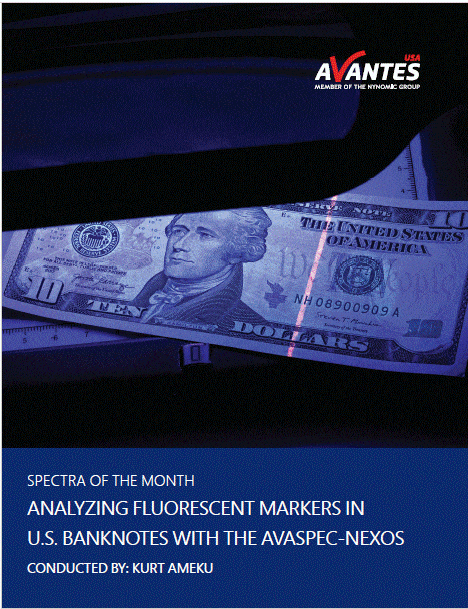Analyzing Fluorescent Markers in U.S. Banknotes with the AvaSpec-NEXOS
 This Spectra of the Month (SOTM) report explores the use of fluorescence spectroscopy to identify security features in U.S. banknotes and detect potential counterfeit currency. U.S. bills of $5 and higher contain fluorescent security threads that emit distinct colors under UV light. While some colors are easily visible, others—such as those in the $10, $50, and $100 bills—can be difficult to distinguish with the naked eye. This experiment aimed to quantify the fluorescence emission spectra of each denomination and evaluate how well the measured data aligned with the reported dye colors.
This Spectra of the Month (SOTM) report explores the use of fluorescence spectroscopy to identify security features in U.S. banknotes and detect potential counterfeit currency. U.S. bills of $5 and higher contain fluorescent security threads that emit distinct colors under UV light. While some colors are easily visible, others—such as those in the $10, $50, and $100 bills—can be difficult to distinguish with the naked eye. This experiment aimed to quantify the fluorescence emission spectra of each denomination and evaluate how well the measured data aligned with the reported dye colors.
Using the AvaSpec-NXS2048CL (AvaSpec-NEXOS™) spectrometer, the fluorescence of $5, $10, $20, $50, and $100 bills was measured with a 395 nm UV flashlight as the excitation source. A long-pass filter was used to eliminate the excitation peak, allowing clear detection of the emitted light from each fluorescent thread. The setup included a collimating lens, fiber optic cable, and clamp-based stand to ensure consistent measurement.
The results showed distinct fluorescence peaks for each bill, with emission wavelengths aligning closely with their reported colors—blue, orange, green, yellow, and pink/red respectively. Notably, the $10 bill exhibited overlapping peaks seen in both the $50 and $100 bills, supporting its classification as orange. The $100 bill also produced the weakest fluorescence, consistent with known anti-counterfeiting strategies that involve subtler emissions to foil fake reproduction.
This study demonstrates the practical application of compact, fiber-coupled spectrometers for counterfeit detection and quality control. Future work may include deeper spectral analysis to quantify peak magnitudes and widths, offering enhanced verification methods against increasingly sophisticated counterfeit threats.
Read More:
 My Cart
My Cart 